On my first time in Italy in January 2018, I saw Rome, Florence and Sienna. On my second time in February 2019, I saw Carrera, Pisa and Livorno and then took the ferry from Livorno to Bastia, Corsica on February 25.
I took the Flixbus from Rome to Florence (10€ – this bus line offers unbelievably cheap bus fares on new, comfortable buses with wi-fi). But after arriving, it took me over 3 hours to get to my BnB. The bus stops had changed because of road construction and I waited an hour for the bus that never came. Everyone at the shop said that my bus, 1A came here “it’s Italy, nothing runs on time.” That is not true, the buses keep to the published schedule but during the traffic jams, maybe late. Alessandro was a wonderful host for my 5 days in Florence. The new part of his house dates to the 16th century and has 8m ceilings with massive wood roof beams. The old part of the house (used to be a convent) dates to the 14th and 13th centuries. Again I had a long list of Nomad Mania sights to see in my 4 days in Florence. I walked from the BnB to the center in about 45 minutes, both there and back every day.
History. The Etruscans were here in 300 BC but Julius Caesar founded Florencia in 59BC. The plague in 1348 halved the city’s population. After a revolt by the wool workers in 1378, the Medici family – bankers to the pope – took a major role in city government. In 1434, Cosimo the Elder became Florence’s de facto ruler. With an eye for talent, artists like Donatello and Lippo flourished. The rule of his grandson, Lorenzo the Magnificent (1469-92), ushered in the Italian Renaissance, and Florence became Italy’s cultural capital of art, music, and poetry. Not long before his death, the Medici bank failed and the family was driven out of Florence. The Spanish under Emperor Charles V and Cosimo I, one of the last truly great Medici rulers took charge, defeated Siena and Cosimo became the Grand Duke of Tuscany. It was eventually incorporated into the Kingdom of Italy in 1860. WWII severely damaged the city and floods ravaged the city in 1966. Since 1997, the world-class Uffizi Gallery has invested millions of Euros.
The Firenze Card (72€) is valid for 72 hours and gives entrance to some of the museums, villas, and gardens in Florence, as well as free public transport and free wi-fi across the city. The biggest advantage is avoiding the long queues, but you need to visit a lot of museums to justify the cost. There are few cost reductions for over 65-year-olds.
Basilica of San Lorenzo. Consecrated in 393AD, the Medici reconstructed it for the third time in 1429, making it the first Renaissance building in history. The colour is plain with white walls and grey stone for the columns and detail. The chapels each have a masterpiece painting: Lippi’s The Annunciation and Fiorentino’s Marriage of the Virgin are standouts. Donatello’s two pulpits sit atop marble pedestals covered in bronze panels. The Old Sacristy has Donatella-painted terracotta statues and bronze doors and a gold and lapis lazuli frescoed dome. There are many Medici family tombs. A museum is also included in the price.

Palazzo Medici-Riccardi*. This palace is the Medici townhouse built in 1444. It is not so interesting. The upstairs chapel is covered in wonderful frescoes.

Museo di Zoology and Natural History. I only went here as it is on the Nomad Mania list and regretted it. The mineral display is fascinating but the hundreds of stuffed animals in glass display cases were ugh. Access to the observatory is restricted.
Palazzo Pitti. This massive palace was the residence of the Medicis. It has a silver collection, and a few art gallery rooms recreating life in Renaissance times. I didn’t go in but crossed through to the Bobili Gardens. Walk to the top of the gardens to get great views. Exit here next to the Belvedere Fort for more panoramic views of the city. After descending to the Arno River, cross the Ponte Vecchio. Dating to 1345, this bridge was the only Florentine bridge to survive destruction at the hands of retreating German forces in 1944. The first documented stone bridge, at the narrowest point along the entire length of the Arno, dates from 972. The bridge is thronged with tourists and is unusual for all the 2 story houses that cover its sides. They house expensive jewelry stores and restrict views of the river.
Museo Galileo. On the river to the east of the bridge, is this state-of-the-art science museum. I didn’t go in but had a good look at the lovely huge sundial on the sidewalk outside.
Galleria dell’Accademia. This gallery holds one of the Renaissance’s iconic masterpieces, Michelangelo’s David, the world’s most famous statue.

Piazza della Signoria and around. This large square has been the hub of local life since the 13th century. On the south side is an open-air gallery of Renaissance sculptures: Giambologna’s Rape of the Sabine Women (1583), Cellini’s bronze Perseus (1554), and a host of other statues.
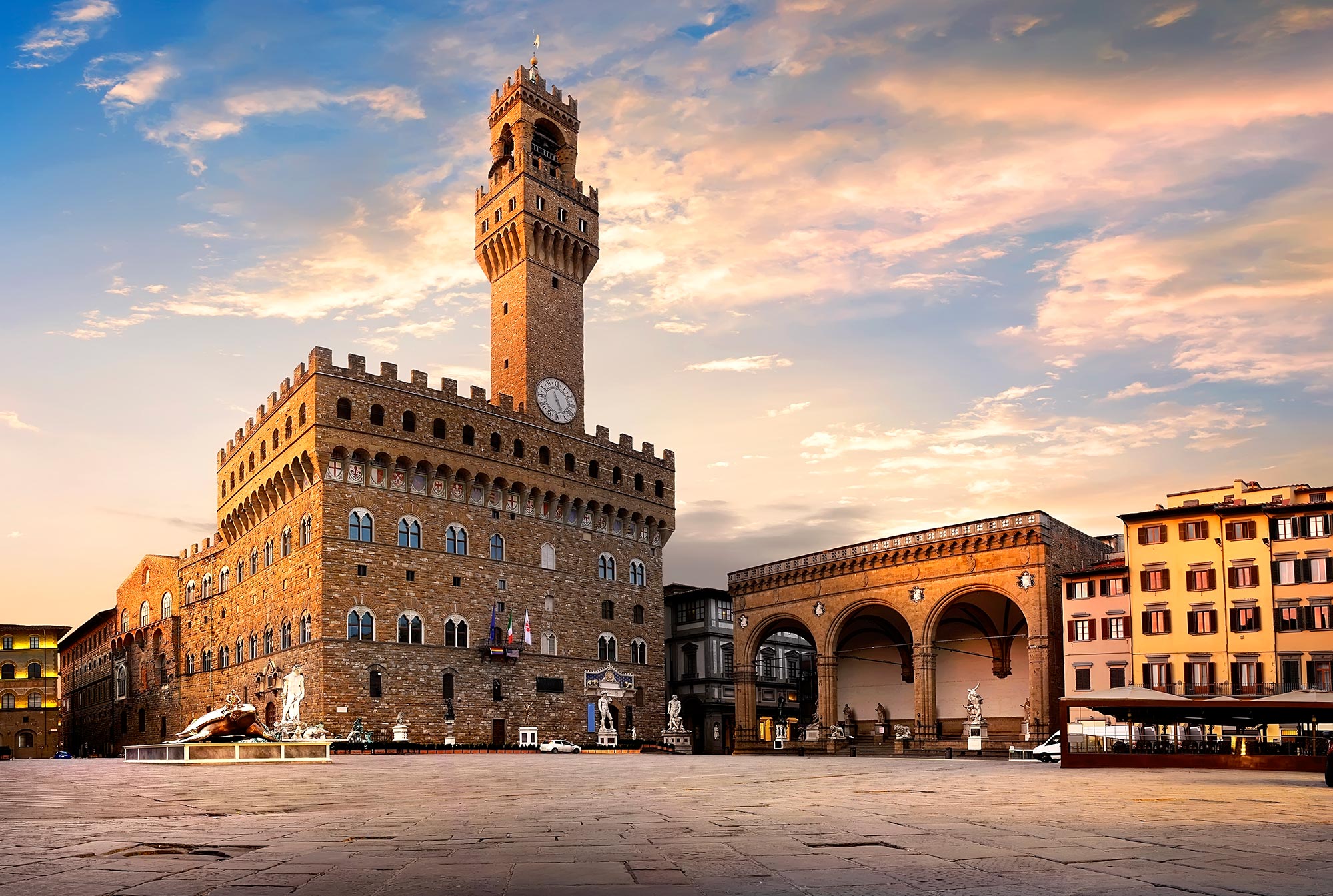
It was here that Savonarola, a puritanical Dominican monk burned the city’s wealth – books, paintings, musical instruments, mirrors, and fine clothes on the “Bonfire of the Vanities” in 1497 and was declared a heretic, hung in chains and burned in 1498. A copy of Michelangelo’s David stands outside the Palazzo Vecchio, a Medici fortress-palace with a 94m-high tower (418 steps). It has an impressive 53x22m salon with frescoes painted floor to ceiling, private apartments a room of 16th-century maps. The Neptune Fountain (being restored and covered up when I was there), looked amazing. The equestrian statue of Cosimo I is in the center of the square. On the east side is the Gucci Museum. Go through the retail store (who buys this stuff, often very gaudy and very expensive) to see the museum.
Baptistery. Dating to the 4th and 5th centuries, this is not to be missed for the amazing mosaics that cover the inside of the dome. The bronze doors and art are also good.
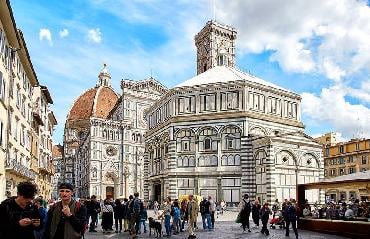

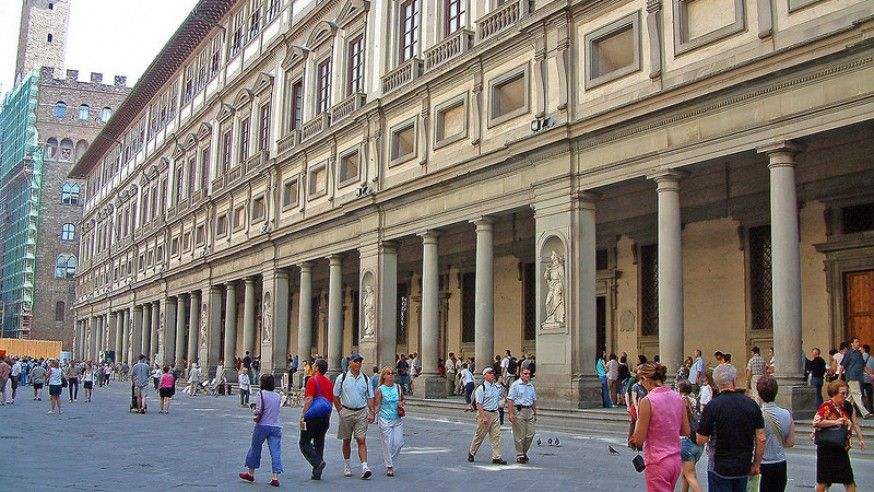
Visits are best kept for 3-4 hours to avoid gallery fatigue. The views from the roof-top garden are memorable. After an exhausting 4 hours, I had a sandwich at the famous All’Antico Vinalo. Join the crowd waiting in line for the 5€ well-stuffed focaccia to take away. I walked home and had a nap to get ready for my flight to Leipzig in the morning. I flew from Florence via Dusseldorf to Leipzig. My friend Christian met me. I met Christian in Petra 2 years ago. He has been a life-saver and for me, it shows the value of talking to people you meet traveling. It is not possible to register and buy insurance for a vehicle without an address and Christian offered me the use of his address.
SIENA (pop 54,000) I arrived on the Flixbus from Genoa. A series of several escalators accessed in the shopping near the bus stop takes you to the top of the hill and the old center. It took about 30 minutes to walk to my BnB in the center. I saw all the following in the morning and then caught the Flixbus to Rome (10€) in the late afternoon. There is a strong rivalry between Florence (Renaissance) and Siena (Gothic).
History. Originally an Etruscan town, it didn’t start to grow until the 1st century BC when the Romans established a military colony called Sena Julia. In the 12th century, wealth and power grew from commerce and wars with Florence forced it to rival it in 1270. In 1348, the plague killed ⅔ of its 100,000 inhabitants, caused a decline and the Medicis of Florence barred banks, severely curtailing its power. This resulted in little development and the historic center’s inclusion on Unesco World Heritage List the living embodiment of a medieval city.
Plazza del Campo. This huge sloping plaza has been the civic and social center since the mid-12th century. Since 1346, its Fonte Gala (Happy Fountain) with its sculpted panels has been the highlight. The Palazzo Communale has a bell tower with 500 steps to the top and grand views.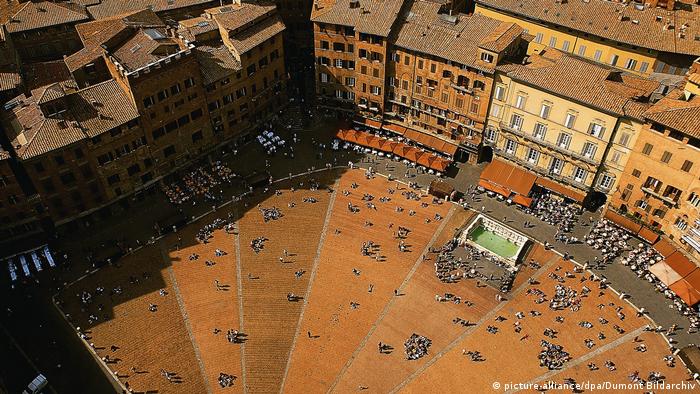
Duomo. Siena’s cathedral (from 1215) is one of Italy’s most awe-inspiring churches. The white, green, and red marble façade is matched by its interior with sculptures, marvellous floor frescoes, and art. The Museo dell’Opera del Duomo houses art that formerly adorned the cathedral (12 statues of the prophets and philosophers and the striking Maestra). The Baptistery is lined with frescoes and a hexagonal marble font decorated with bronze panels. The Cripta has 180 sq. m of dry mural paintings. Climb the 131 steps to the Panorama del Facciatone for the best views of Siena’s unique cityscape.
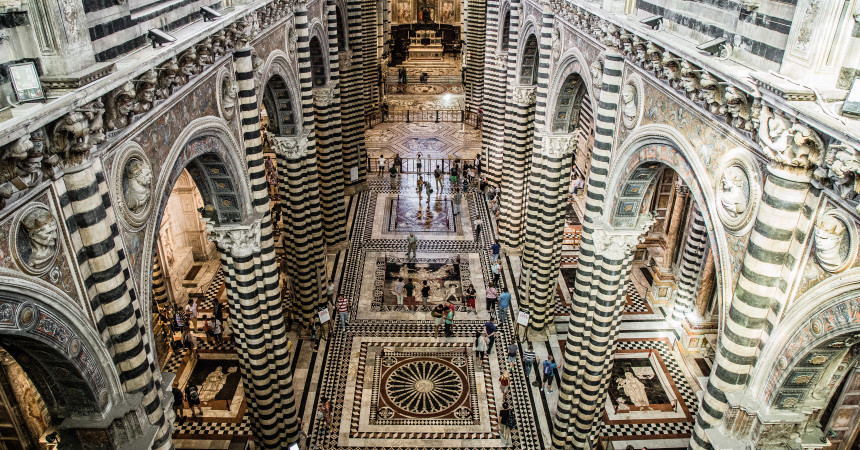
Chiesa di San Domenico. Dedicated to St Catherine, the church has her in a 15th-century tabernacle.
Carrera. Famous around the world for its white marble, I saw the quarries, a 13km drive east from the town center. There is a city museum at the tourist information center and three “tours” at the center of the quarries: Cava Museo €2, Marmo Tours that go into the huge cave, and a 4×4 jeep tour that ascends the working switchbacks. The marble quarries are a tentative UNESCO World Heritage Site.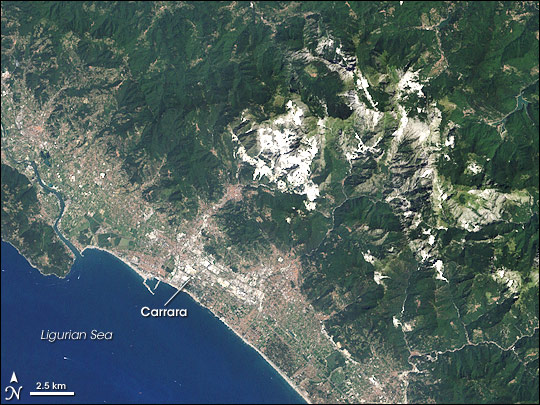

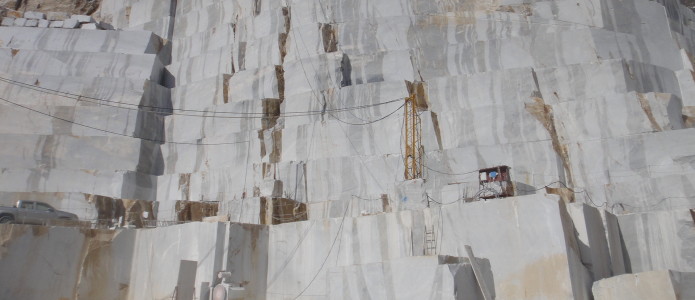
LUCCA. On the Serchio, in a fertile plain near the Tyrrhenian Sea, it is famous for its intact Renaissance-era city walls. History. It was founded by the Etruscans in the 3rd century BC and called Luk meaning marsh and became a Roman colony in 180 BC. The rectangular grid of its historical center preserves the Roman street plan, and the Piazza San Michele occupies the site of the ancient forum. Traces of the amphitheatre may still be seen in the Piazza dell’Anfiteatro. Lucca was an important city and fortress even in the sixth century when Narses besieged it for several months in 553. Under the Lombards, it was the seat of a duke who minted his coins. The Holy Face of Lucca (or Volto Santo), a major relic supposedly carved by Nicodemus, arrived in 742. During the eighth and tenth centuries Lucca was a center of Jewish life, many of whom migrated to Germany to become a major component of proto-Ashkenazic Jewry). Lucca became prosperous through the silk trade that began in the eleventh century and came to rival the silks of Byzantium. During the tenth–eleventh centuries Lucca was the capital of the feudal margraviate of Tuscany, more or less independent but owing nominal allegiance to the Holy Roman Emperor. In the 1400s, it was occupied by Louis of Bavaria, sold to a rich Genoese, then seized by John, king of Bohemia, pawned to the Rossi of Parma, ceded to Mastino II della Scala of Verona, sold to the Florentines, surrendered to the Pisans, and then nominally liberated by the emperor Charles IV and governed by his vicar. Lucca managed, at first as a democracy, and after 1628 as an oligarchy, to maintain its independence alongside Venice and Genoa. In 1805, Lucca was conquered by Napoleon, who installed his sister Elisa Bonaparte Baciocchi as “Princess of Lucca”. From 1815 to 1847 it was a Bourbon-Parma duchy, then lost independence and was annexed to the Grand Duchy of Tuscany. As part of Tuscany, it became part of the Kingdom of Sardinia in 1860 and finally part of the Italian State in 1861. Lucca hosts the annual Lucca Summer Festival.
Historic Center of Lucca. A tentative WHS, it is surrounded by a complete set of walls that remain intact, even as the city expanded and modernized, unusual for cities in the region. Initially built as a defensive rampart, once the walls lost their military importance they became a pedestrian promenade, the Passeggiata delle Mura Urbane. Each of the four principal sides of the structure is lined with a different tree species than the others. A great walk, all the bastions are lovely grass, trees, benches, and playgrounds. The town includes several public squares, most notably the Piazza dell’Anfiteatro. Site of the ancient Roman amphitheatre, it is a perfect oval enclosed by buildings and 4 small entrances with cafes and knick-knack shops. There are also many fine churches, all with white marble faces and all charge an entrance fee, unusual for Catholic churches: Chiesa dei Santi Giovanni e Reparata, the cathedral, is white and green marble with many columns and tiles. €7. The square bell tower top is marble. €3 Basilica Di San Frediano has a nice mosaic on the outside. €3 Lucca Botanical Garden (Orta Botanico). This walled park is within the old city walls. Mostly trees and grass, it was closed with no signs of when it opened. There were no greenhouses or flowers at this time of year. Look down on it from the walls.
PISA (pop 92,000) Straddling the Arno just before it empties into the Ligurian Sea and known worldwide for its leaning tower (the bell tower of the city’s cathedral), it contains more than 20 other historic churches, several medieval palaces, and various bridges across the Arno. Much of the city’s architecture was financed from its history as one of the Italian maritime republics.
History. The origin of the name, Pisa, is a mystery. While the origin of the city had remained unknown for centuries, the Pelasgi, the Greeks, the Etruscans, and the Ligurians had variously been proposed as founders of the city. Archaeological remains from the fifth century BC confirmed the existence of a city at the sea, trading with Greeks and Gauls. Pisa took advantage of being the only port along the western coast between Genoa (then a small village) and Ostia. In 180 BC, it became a Roman colony under Roman law, as Portus Pisanus. Pisa supposedly was founded on the shore, but due to the alluvial sediments from the Arno and the Serchio, whose mouth lies about 11 km (7 mi) north of the Arno’s, the shore moved west. Strabo states that the city was 4.0 km (2.5 mi) away from the coast. Currently, it is located 9.7 km (6 mi) from the coast. However, it was a maritime city, with ships sailing up the Arno. Pisa began in this way its rise to the role of the main port of the Upper Tyrrhenian Sea and became the main trading center between Tuscany and Corsica, Sardinia, and the southern coasts of France and Spain. In 860, Pisa was captured by Vikings led by Björn Ironside. The power of Pisa as a maritime nation began to grow and reached its apex in the 11th century when it acquired traditional fame as one of the four main historical maritime republics of Italy. Pisa was in continuous conflict with the Saracens, who had their bases in Corsica, for control of the Mediterranean. The Norman Roger I, took Palermo from the Saracen pirates. The gold treasure taken from them allowed the Pisans to start the building of their cathedral and the other monuments which constitute the famous Piazza del Duomo. In 1092, Pope Urban II awarded Pisa supremacy over Corsica and Sardinia, and at the same time raised the town to the rank of the archbishopric. A Pisan fleet of 120 ships also took part in the First Crusade, and the Pisans were instrumental in the taking of Jerusalem in 1099. In particular, the Pisans founded colonies in Antiochia, Acre, Jaffa, Tripoli, Tyre, Latakia, and Accone. They also had other possessions in Jerusalem and Caesarea, plus smaller colonies (with lesser autonomy) in Cairo, Alexandria, and Constantinople. In all these cities, the Pisans were granted privileges and immunity from taxation but had to contribute to the defence in case of attack. Pisa’s decline is said to have begun on August 6, 1284, when the numerically superior fleet of Pisa was defeated by the brilliant tactics of the Genoese fleet. This defeat ended the maritime power of Pisa and the town never fully recovered. The end came when the Arno started to change course, preventing the galleys from reaching the city’s port up the river. The nearby area also likely became infected with malaria. The true end came in 1324 when Sardinia was entirely lost to the Aragonese. In the 15th century, access to the sea became more and more difficult, as the port was silting up and was cut off from the sea. Pisa acquired a mainly cultural role spurred by the presence of the University of Pisa, created in 1343, and later reinforced by the Scuola Normale Superiore di Pisa (1810) and Sant’Anna School of Advanced Studies (1987). Pisa was the birthplace of the important early physicist Galileo Galilei. It is still the seat of an archbishopric. Besides its educational institutions, it has become a light industrial center and a railway hub. It suffered repeated destruction during World War II. Since the early 1950s, the US Army has maintained Camp Darby just outside Pisa, which is used by many US military personnel as a base for vacations in the area. Some segments of the original town walls remain.
Piazza del Duomo. While the bell tower of the cathedral, known as “the Leaning Tower of Pisa”, is the most famous image of the city, it is one of many works of art and architecture in the plaza, all coordinated of white and green marble with a huge perfect lawn. On a Sunday, it was crowded.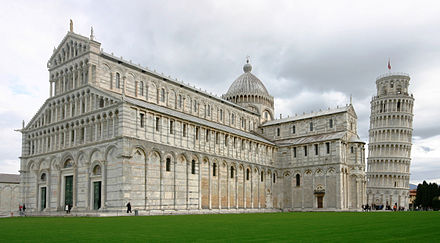
Leaning Tower of Pisa. It is the freestanding bell tower of the Cathedral of Pisa, known worldwide for its unintended tilt. The tower is situated behind the cathedral and is the third oldest structure in the city’s Cathedral Square (Piazza del Duomo), after the cathedral and the Pisa Baptistry. The tower’s tilt began during construction in the 12th century, caused by an inadequate foundation on the ground too soft on one side to properly support the structure’s weight. The tilt increased in the decades before the structure was completed in the 14th century. It gradually increased until the structure was stabilized (and the tilt partially corrected) by efforts in the late 20th and early 21st centuries. The height of the tower is 55.86 meters (183.27 feet) from the ground on the low side and 56.67 meters (185.93 feet) on the high side. The width of the walls at the base is 2.44 m (8 ft 0.06 in). Its weight is estimated at 14,500 metric tons. The tower has 296 or 294 steps; the seventh floor has two fewer steps on the north-facing staircase. In 1990 the tower leaned at an angle of 5.5 degrees, but following remedial work between 1993 and 2001, this was reduced to 3.97 degrees, reducing the overhang by 45 cm at a cost of £200m. It lost a further 4 cm of tilt in the two decades to 2018. Construction of the tower occurred in three stages over 199 years. Work on the ground floor of the white marble campanile began on August 14, 1173, during a period of military success and prosperity. This ground floor is a blind arcade articulated by engaged columns with classical Corinthian capitals. The tower began to sink after construction had progressed to the second floor in 1178. This was due to a mere three-meter foundation, set in the weak, unstable subsoil, a design that was flawed from the beginning. Construction was subsequently halted for almost a century because the Republic of Pisa was almost continually engaged in battles with Genoa, Lucca, and Florence. This allowed time for the underlying soil to settle. Otherwise, the tower would almost certainly have toppled. In 1272, construction resumed and to compensate for the tilt, the engineers built upper floors with one side taller than the other. Because of this, the tower is curved. Construction was halted again in 1284 when the Pisans were defeated by the Genoans. The seventh floor was completed in 1319. The bell chamber was finally added in 1372. There are seven bells, one for each note of the musical major scale. The largest one was installed in 1655. After a phase (1990–2001) of structural strengthening, the tower is currently undergoing gradual surface restoration, to repair visible damage, mostly corrosion, and blackening. These are particularly pronounced due to the tower’s age and its exposure to wind and rain. Numerous efforts have been made to restore the tower to a vertical orientation or at least keep it from falling over. Most of these efforts failed; some worsened the tilt. In 1964, the government of Italy requested aid in preventing the tower from toppling. It was, however, considered important to retain the current tilt, due to the role that this element played in promoting the tourism industry of Pisa. In 1990, a multinational task force of engineers, mathematicians, and historians gathered to discuss stabilization methods. The bells were removed to relieve some weight, and cables were cinched around the third level and anchored several hundred meters away. The solution chosen to prevent the collapse of the tower was to slightly straighten it to a safer angle by removing 38 cubic meters (1,342 cubic feet) of soil from underneath the raised end. The tower was straightened by 45 centimetres (17.7 inches), returning to its 1838 position. After a decade of corrective reconstruction and stabilization efforts, the tower was reopened to the public on December 15, 2001, and was declared stable for at least another 300 years. In total, 70 metric tons of earth were removed. At least four strong earthquakes hit the region since 1280, but the vulnerable Tower survived as it was able to withstand the tremors because of dynamic soil-structure interaction (DSSI): the height and stiffness of the Tower together with the softness of the foundation soil influence the vibrational characteristics of the structure in such a way that the Tower does not resonate with earthquake ground motion. The same soft soil that caused the leaning, and brought the Tower to the verge of collapse helped it survive. Guinness World Records. Two German churches have challenged the tower’s status as the world’s most lop-sided building: the 15th-century square Leaning Tower of Suurhusen (3.97 degrees and the 14th-century bell tower in the town of Bad Frankenhausen. In June 2010, Guinness World Records certified the Capital Gate building in Abu Dhabi as the “World’s Furthest Leaning Man-made Tower”, it has an 18-degree slope, almost five times more than the Pisa Tower, but was deliberately engineered to slant. The Leaning Tower of Wanaka in New Zealand, also deliberately built, leans at 53 degrees to the ground.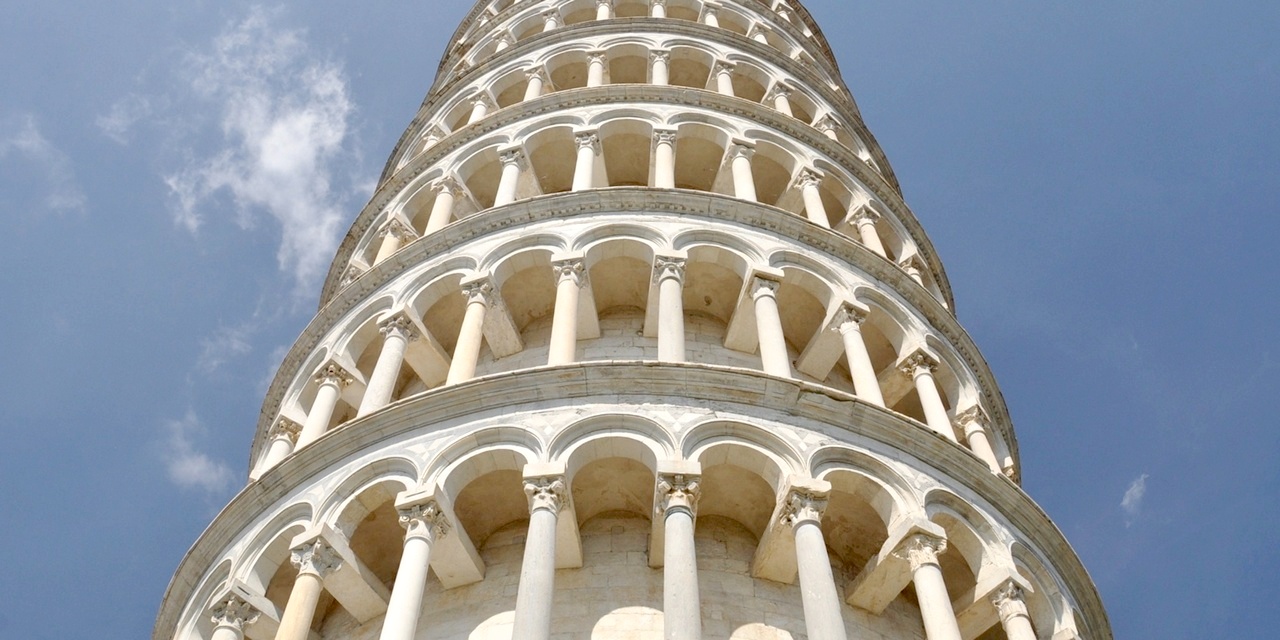
Duomo (the Cathedral). Some of the highlights are the two aisles on each side lined with large paintings and wood benches with outstanding inlays, a modern marble lectern, the urn, and the altar of San Ranieri (d. 1161) whose remains were collected from all over the city and “put back” together, the 1226 painting of the Virgin, the pulpit on marble columns and the great mosaics behind the altar. Free but need a ticket that gives a specific entry time. Pisa Baptistery of St. John. Constructed from 1152 – 1363, it is the largest baptistery in Italy at 54.86 m high and a diameter of 34.13 m. The Baptistery is constructed of marble. Constructed on the same unstable sand as the tower and cathedral, the Baptistery leans 0.6 degrees toward the cathedral. €5 or €7 with the Composanto and Museum of Sinopie.
Campo Santo (the monumental cemetery).
Botanical Garden of Pisa. Founded in 1543, it is the oldest academic garden in the world. It was moved in 1591 and the only remains of the original are 6 large sandstone pools. There are plants from all over the world and it has a central role in scientific research and conservation of biodiversity for the University of Pisa. The highlights are centuries-old trees (a Ginko Biloba from 1787 with a 4m trunk, and a southern magnolia; the Lebanon cedar was destroyed by a storm in 1935), wild edible plants, 150 species of sage, and 4 greenhouses. The museum, with its 1752 grotesque facade, has some unusual things: wax and plaster fungi and wax models of plants. €4
Windmill ruins at Bibbona. This was a hard place to find as Google Maps listed none. 2 sites found on Google briefly mentioned that the area had some old wind and watermills. At first light, I drove around Bibbona and saw this windmill.
Terme di Saturnia. A tentative World Heritage Site, the 50km drive here took 1 1/2 hours on a twisty country road through rolling Tuscan countryside with fields, vineyards, and olive trees. From a viewpoint high above on the road, the hot springs were impressive. They are fed by a narrow stream that originates from springs covering a vast area. The main thermal area is at Mill Falls with an old mill, with a total drop of about 15m on several travertine terraces. This is completely noncommercial with only a small cafe and showers. A small stone building sits on the edge of the large falls at the top but otherwise, it is all-natural. The mineralized blue water is at a constant of 37.7 and flows at about 500l/second. There is only a slight sulphur smell. The best place to sit is under the falls. There is a famed luxury spa, Terme di Saturnia.
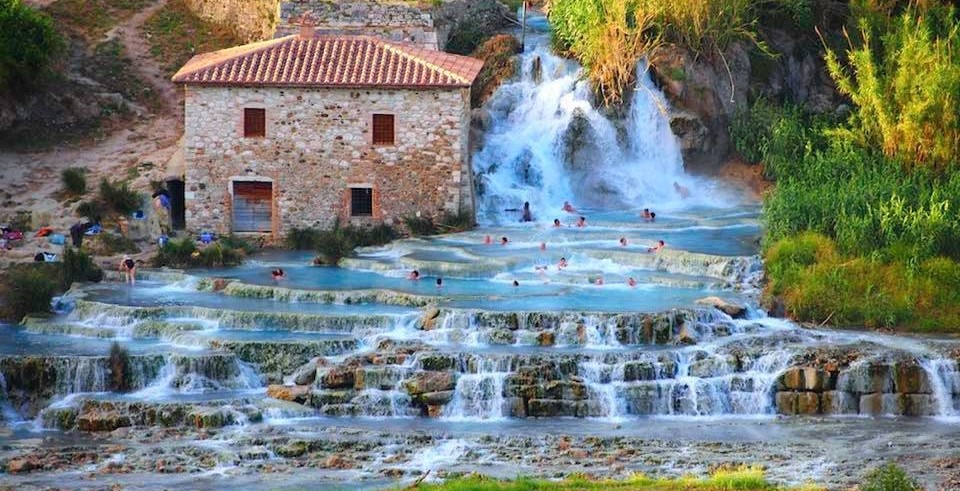
Savona. In the NM “small town” series, it was another slow 27 km drive. Just before the town goes through a tunnel and then a deep rock cut in the tufa walls. I parked in the square surrounded by some interesting buildings: the 12th-century Church of Santa Maria, 16th century Palazzo Bourbon (which holds a classical music festival in August) and the 13th-15th century Pietro Place with sculpted heraldic shields. The Duomo is more modern and west of the square. During archaeological investigations, a treasure of the 5th century 500 golden coins was found.
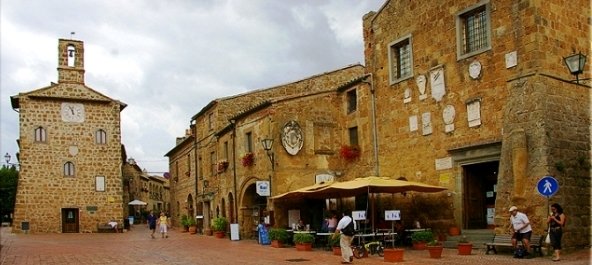
Monte Argentario. A municipality and a peninsula about 150 km S of Florence. The peninsula is connected with the mainland by three spits of land which form two lagoons, the Laguna di Ponente on the west side and the Laguna di Levante on the east side of the middle dam. There are two main villages. The panoramic road Strada Panoramica starts in Porto Santo Stefano allowing splendid views of the coast and the Tuscan Archipelago. The promontory was an island in the past, but the sea currents and the Albenga river joined it with the mainland through two tombolas (stretches of land), the Tombolo of Giannella and the Tombolo of the Feniglia. The highest peak of Monte Argentario is the Punta Telegrafo at 635 meters above sea level. The landscape and the coast are mainly rocky, with numerous harbours, usually with rock beaches. Argentarola cave lies close to Argentario promontory. The high-quality speleothems that have been collected from this cave have allowed scientists to study the 215,000-year history of sea-level oscillations in this region.
Orbetello. Monte Argentario borders the commune of Orbetello, which is located on the middle dam between the two lagoons. Surrounded by water and connected by a causeway to Monte Argentario, it has nice 5th-century walls, the Cathedral of Santa Maria Assunta, built over an Etruscan-Roman temple and restructured in 1375 and notable 15th-century frescoes.
Costa Concordia Shipwreck. On 13 January 2012, the Italian cruise ship Costa Concordia ran aground and overturned after striking an underwater rock off Isola del Giglio, just south of Monte Argentario, resulting in 32 deaths. The eight-year-old Costa Cruises vessel was on the first leg of a cruise around the Mediterranean Sea when she deviated from her planned route at the Isola del Giglio, sailed closer to the island, and struck a rock formation on the seafloor. A six-hour rescue effort brought most of the passengers ashore. An investigation focused on shortcomings in the procedures followed by the crew and the actions of the Italian captain, who left the ship prematurely. About 300 passengers were left on board, most of whom were rescued by helicopter or motorboats in the area. Captain Francesco Schettino was later found guilty of manslaughter in connection with the disaster and sentenced to sixteen years in prison. Despite receiving its own share of criticism, Costa Cruises did not face criminal charges. Costa Concordia was officially declared a “constructive total loss” by the insurance company, and her salvage was “one of the biggest maritime salvage operations”. On 16 September 2013, the parbuckle salvage of the ship began, and by the early hours of 17 September 2013, the ship was set upright on its underwater cradle. In July 2014, the ship was refloated by large sponsons (metal tanks) welded to its sides and was towed 320 kilometres (200 miles) to its home port of Genoa for scrapping which was finished in July 2017. The total cost of the disaster, including victims’ compensation, refloating, towing, and scrapping costs, is estimated at approximately $2 billion, more than three times the $612 million construction cost of the ship. Costa Cruises offered compensation to passengers (to a limit of €11,000 per person) to pay for all damages, including the value of the cruise. 65% of the survivors took the offer.